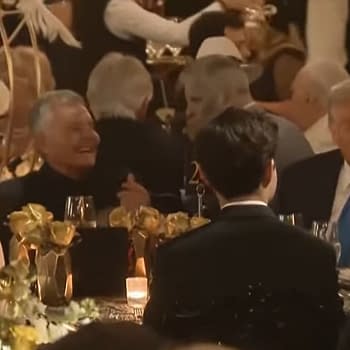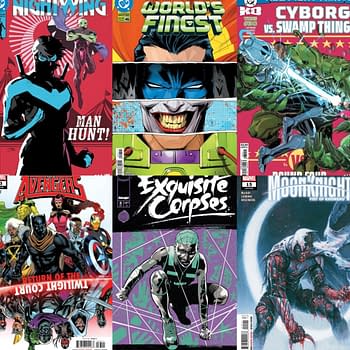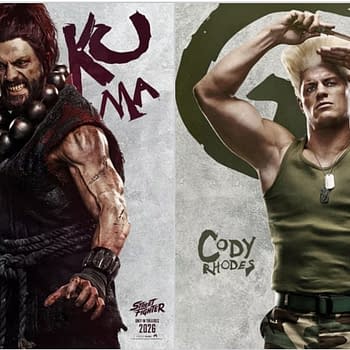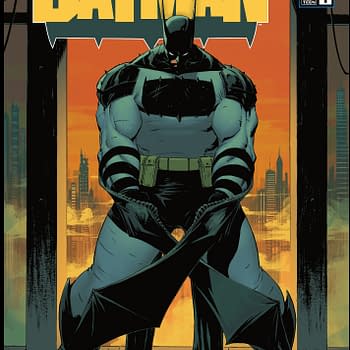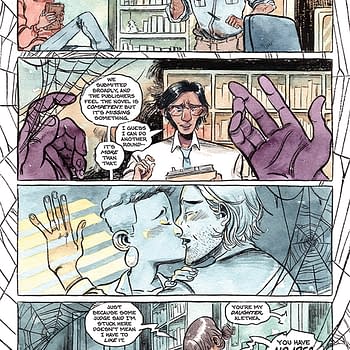Posted in: Comics | Tagged: bob powell, chris claremont, comic con, Comics, Denis Kitchen, eisner awards, entertainment, Francoise Mouly, frank miller, frank roberts, hall of fame, howard cruse, john byrne, Kim Deitch, Lily Renée Peters Phillips, lynda barry, matt groening, Paul S. Newman
Lynda Barry, John Byrne, Chris Claremont, Howard Cruse, Kim Deitch, Matt Groening, Denis Kitchen, Frank Miller, Francoise Mouly, Paul S. Newman, Lily Renée Peters Phillips, Bob Powell And Frank Robbins To Be Voted On For Eisner Awards Hall Of Fame

There are also thirteen choices for the four remaining spots this year – Lynda Barry, John Byrne, Chris Claremont, Howard Cruse, Kim Deitch, Matt Groening, Denis Kitchen, Frank Miller, Francoise Mouly, Paul S. Newman, Lily Renée Peters Phillips, Bob Powell, and Frank Robbins.
Comic book creators, publishers, editors, historians, educators and retailers are invited to vote on their choices. Registration can be found here.
Marjorie Henderson Buell ("Marge") (1904–1993)
In 1935 Marge's single-panel gag cartoon "Little Lulu" first appeared in The Saturday Evening Post. Marge continued producing this hugely popular cartoon featuring the mischievous kid through 1944, when it went on to become a weekly comic strip. Buell stopped drawing Little Lulu in 1947 but although the work was done by others, she kept creative control. Little Lulu became a successful series of animated cartoons and a popular comic book for Dell/Gold Key (done by other cartoonists, most notably John Stanley). Lulu (drawn by Marge) was the mascot for Kleenex tissues from 1952 to 1965.
Bill Woggon (1911–2003)
Bill Woggon created "Katy Keene, the Pinup Queen" for Archie Comics in 1945. Katy appeared not just in her own book but also in Laugh and Pep Comics, giant comics like Katy Keene Pinup Parade, and occasional issues of Archie Giant Series Magazine. Notable about Woggon's comics was that he encouraged fans to send in their designs for clothes (as well as cars and even rocketships), for Katy and her accompanying cast of characters. The series ran until 1961. Woggon then went to work on Millie the Lovable Monster for Dell. A revival of Katy Keene comics occurred in the 1980s, with reprints of Woggon's stories, as well as new stories illustrated by other cartoonists.
Lynda Barry (1956– )
Barry is the creator behind the seminal comic strip Ernie Pook's Comeek, which was syndicated across North America in alternative weeklies from 1979 to 2008. She is the author of The Freddie Stories, One! Hundred! Demons! (which won the 2003 Eisner Award for Best Graphic Album), The! Greatest! of! Marlys!, Cruddy: An Illustrated Novel, and The Good Times Are Killing Me, which was adapted as an off-Broadway play and won the Washington State Governor's Award. She has written two bestselling and acclaimed creative how-to graphic novels: What It Is, which won the 2009 Eisner Award for Best Reality-Based Work and R.R. Donnelly Award for highest literary achievement by a Wisconsin author, and Picture This.
John Byrne (1950– )
Writer/Artist John Byrne is best known for his long run on Uncanny X-Men (beginning with writer Chris Claremont in 1977), including the classic "Days of Future Past" and "Dark Phoenix" story arcs. During that time he created Alpha Flight, Proteus, and Kitty Pryde. This work was followed by a five-year run (1981–1986) on Fantastic Four along with the Alpha Flight series. In 1986 he revamped Superman for DC and worked on various Superman titles for two years, after which he returned to Marvel to write and draw such titles as The Sensational She-Hulk, Namor the Sub-Mariner, and West Coast Avengers. In the 1990s he produced the creator-owned series Next Men for Dark Horse. He continues to produce work for DC, Marvel, IDW, and other publishers.
Chris Claremont (1950– )
Writer Chris Claremont is well known for his 17-year run on The Uncanny X-Men, for which he created or co-created such characters as Rogue, Phoenix, Mystique, Sabretooth, and Gambit. His story arcs in collaboration with John Byrne included such classics as "Dark Phoenix" and "Days of Future Past." His Wolverine minseries with artist Frank Miller inspired the storyline for the 2013 film The Wolverine. The 1991 X-Men #1 spinoff issue, which Claremont co-wrote with Jim Lee, remains the bestselling comic book of all time. In the 1990s Claremont wrote a variety of titles for several publishers, including his own Sovereign Seven for DC, as well as some prose novels. He returned to Marvel in 1998 as editorial director and the regular writer of Fantastic Four. Today he continues to write novels and to work for Marvel, writing such titles as X-Women and Nightcrawler.
Howard Cruse (1944– )
Howard Cruse first appeared on the national comics scene with his underground strip Barefootz in 1972. In 1979 he began editing Gay Comix, an anthology featuring comics by openly gay and lesbian cartoonists. In 1983 Cruse introduced his comic strip Wendel to the pages of The Advocate, the national gay newsmagazine, where it appeared regularly until 1989. His 1995 graphic novel Stuck Rubber Baby (published by Paradox Press) won Eisner and Harvey Awards and went on to be translated into numerous languages around the world; it was republished by Vertigo in 2010.
Kim Deitch (1944– )
Deitch is an underground cartoonist best known for his recurring character Waldo the Cat, a fictional 30s-era animated cat. Waldo stars in the seminal Boulevard of Broken Dreams (an issue of which received an Eisner award in 2003), Shroud of Waldo, Alias the Cat, and various other strips and serials. Deitch has also released Shadowlands, and Deitch's Pictorama, a collaboration with brothers Simon and Seth. Art Spiegelman has called Deitch "the best kept secret in American comics." Deitch has also been a publisher, as co-founder of the Cartoonists Co-op Press, and has taught at the School for Visual Arts in New York.
Matt Groening (1954– )
Matt Groening, creator and executive producer of The Simpsons, the longest running primetime animated series in television history, started out as a cartoonist, producing the syndicated weekly strip Life in Hell beginning in 1978; he continued the strip until 2012. In 1985 he was asked to come up with an animated short to be part of Fox's Tracey Ullman Show; the rest is history. Groening's other award-winning animated series, Futurama, launched 1999 and ran for five seasons. In 1993, he formed Bongo Comics Group, where he serves as publisher of Simpsons Comics, Futurama Comics, and dozens of other titles.
Denis Kitchen (1946– )
Denis started out as an underground cartoonist. After self-publishing his own work in 1969, he founded Kitchen Sink Press in 1970. Under the name of the Krupp Syndicate, he syndicated comic strips to almost 50 underground and college newspapers. Over the course of the next few decades Kitchen Sink published such cartoonists as R. Crumb, Art Spiegelman, S. Clay Wilson, Howard Cruse, Harvey Kurtzman, Will Eisner, Al Capp, Alan Moore, Neil Gaiman, Scott McCloud, and dozens more. In 1986 Denis founded the Comic Book Legal Defense Fund, and he served as the fund's president until his retirement in 2004.
Frank Miller (1957– )
Frank Miller had drawn a few short comics stories for DC and Marvel before he got his first regular series, Daredevil, in 1979. In 1981 he took over writing and drawing the series, introducing such characters as Elektra and Bullseye. After drawing the classic Wolverine miniseries by Chris Claremont, he went over to DC, first producing his own Ronin miniseries, then going on to create such 1980s classics as Batman: The Dark Knight Returns, Batman: Year One (with David Mazzucchelli), Daredevil: Born Again (with Mazzucchelli), and Elektra: Assassin (with Bill Sienkiewicz). In the 1990s, he moved to Dark Horse, which published his Hard Boiled (with Geof Darrow), Big Guy and Rusty the Boy Robot (with Darrow),Give Me Liberty (with Dave Gibbons), Sin City, and 300. In this century he has been active as a film director (Sin City) along with doing such comics projects as Batman: The Dark Knight Strikes Again, All-Star Batman & Robin, the Boy Wonder, and Holy Terror.
Francoise Mouly (1955- )
Editor and publisher Francoise Mouly founded Raw Books and Graphics in 1978. With her husband Art Spiegelman she launched Raw magazine in 1980, which is perhaps best known for serializing Spiegleman's award-winning Maus. A lavishly produced oversize anthology, Raw published work by Lynda Barry, Charles Burns, Kim Deitch, Ben Katchor, Richard McGuire, Lorenzo Mattotti, Gary Panter, Joost Swarte, Jacques Tardi, and Chris Ware, to name but a few. When Mouly became art director at The New Yorker in 1993, she brought a large number of cartoonists and artists to the periodical's interiors and covers. In 2008 she launched Toon Books, an imprint devoted to books for young readers done by cartoonists.
Paul S. Newman (1924–1999)
Credited in the Guiness Book of World Records as the most prolific comic book writer, with more than 4,100 published stories totaling some 36,000 pages, Paul S. Newman is otherwise best known for scripting the comic book series Turok for 26 years, as well as the Lone Ranger newspaper strip for 14 years. Newman broke into comic books in 1947 with DC's teen-humor series A Date with Judy. He went on to script for Avon Comics, Fawcett, Hillman, St. John, Ziff Davis, and Timely, to name a few. At Marvel he wrotePatsy Walker and other teen titles. In the Silver Age he wrote hundreds of Gold Key comics and co-created Dr. Solar. Well into the 1980s he was still writing comic books for DC (G.I. Combat, House of Mystery) and such offbeat titles as Darkwing Duck.
Lily Renée Peters Phillips (1925– )
Lily Renée was the star comic artist for publisher Fiction House, where she worked from 1943 until 1948. She drew such strips as Werewolf Hunter, Jane Martin, Senorita Rio, and The Lost World. She was known for her striking covers and good girl art. She later drew Abbott & Costello Comics with her husband at the time, Eric Peters, and Borden's Elsie the Cow comics. She left comics in the 1950s.
Bob Powell (1916–1967)
Powell went to work for the Eisner-Iger studios in the late 1930s, including drawing strips for Fiction House (Jumbo Comics), Fox (Wonderworld Comics, Mystery Men Comics), Harvey (Speed Comics), Timely, and Quality (Crack Comics, Hit Comics, Military Comics). His most famous series during his Eisner-Iger years was "Sheena," which appeared in Jumbo Comics. Later, Powell worked in Will Eisner's personal studio and co-plotted the first Blackhawk story in Quality's Military Comics. After the war, Powell went freelance, drawing for such publishers as Street & Smith (Shadow Comics), Harvey (Man in Black, Adventures in 3-D), and Marvel (Daredevil, Giant-Man). Powell also did the pencil art for the famous bubble gum trading card series Mars Attacks. In 1961 he became art director for Sick magazine, a position he held until his death in 1967.
Frank Robbins (1917–1994)
In 1939, cartoonist Frank Robbins took over the daily strip Scorchy Smith from Noel Sickles. When King Features asked him to create an aviation comic, he came up with Johnny Hazard, which was launched in 1944 and ran until 1977. During the 1960s, Robbins drew such comic book series as Batman, The Flash, and The Unknown Soldier. After 1977, he worked for Marvel on Captain America, Ghost Rider and other titles. He eventually retired from comics and emigrated to Mexico, dedicating himself to painting. His fine art has been exhibited in several museums and galleries.
– See more at: http://www.comic-con.org/awards/will-eisner-hall-of-fame-2015-nominees#sthash.shYGGqCO.dpuf





















